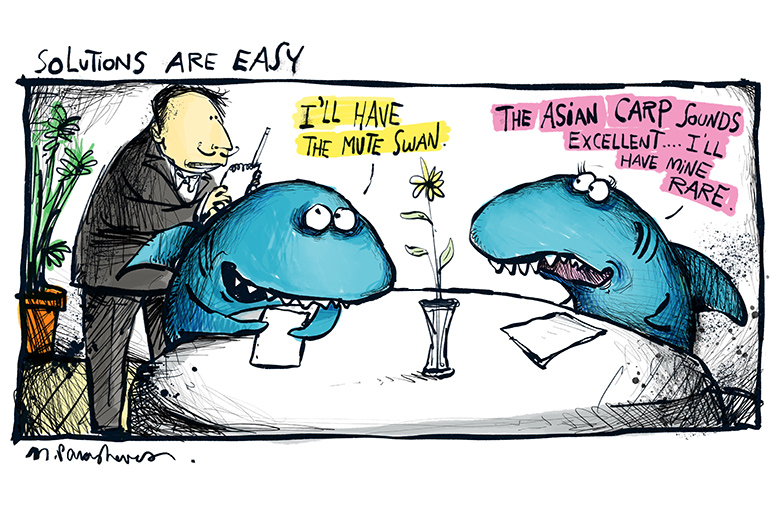Carp Attack: This Invasive Fish Has Been Found in Mill Pond in Water Mill

I don’t know if you’re aware of this, but work on a huge fish barrier costing $778 million will begin shortly on the Des Plaines River near the town of Joliet, Illinois. It’s hoped that this barrier can prevent a particular large and vicious fish that eats everything from swimming further downstream into Lake Michigan.
The fish are Asian carp. They can grow to be four feet long and weigh 100 pounds, and they can use their very sharp teeth—not in their jaws but in their throats (yes in their throats), swimming along and snarling as they suck in and chew plankton, small fish and other things to up to 40% of their body weight every day. They’ve entered the country from the Gulf of Mexico into New Orleans and have made their way up the Mississippi River almost to Chicago. Wherever they go, they drive off, starve out or eat up other species of fish, and with the females laying more than 1,000 eggs a year, the carp become the only game in town.
The prize awaiting them in Lake Michigan is the billions of fish worth $7 billion a year to the state’s fishing industry. The barriers on the Des Plaines are expected to be completed in 2027. A barrier that gives carp electric shocks in the Chicago Sanitary and Ship Canal has had problems. A barrier on the Illinois River at Havana, Illinois, is already working. But still, a few carp are getting through.
I mention all of this because alarmingly, last week, carp are reported to have arrived into the Lower Mill Pond, Water Mill. The carp seem to have gotten in by swimming in from the ocean and up Mecox Bay, to then pass under the Montauk Highway bridge just to the west of town. This is the first carp invasion that I know of here in the Hamptons. Fishermen with rod and reel and boaters with nets are being urged to capture the carp and kill them. It is hoped they can be stopped here in the lower pond before they get to the larger upper pond further inland, and from there to elsewhere—into your home’s outfall pipes, for example.
The carp, an invasive species, were years ago imported to America from China to control parasite hosts eating snails inside aquaculture facilities. Asian carp were also brought in to eat ravenously through nuisance algae blooms and aquatic vegetation in fish aquaculture facilities, sewage lagoons and farm ponds. But rainstorm floods enabled the carp to struggle out of these enclosed environments, so here we are.
You may also have read that there has been an increase in shark attacks along the Atlantic shoreline. It is still true that suffering a shark attack is about as likely as being struck by lightning, but human intervention has caused this new problem. The number of sharks in the ocean had been seen to be declining. The sharks might go extinct if nothing was done. So laws were passed making it a crime to kill certain sharks. Now the shark population is on the upswing. More sharks mean more bites.
It occurs to me that luring big sharks into Illinois or Water Mill could result in a huge battle with the carp, leading to the decline in population of both these critters.
We could also lure in our mute swans. Two years ago, the State of New York considered passing a law to have all the mute swans in the state killed. Mute swans, like the carp, are also an invasive species. Around 1900, rich Americans captured these swans in Belgium and took them across the Atlantic to grace the ponds in small towns in America. Paddling about, they would become a peaceful and glorious addition to any community. The proposed law to have them killed came about because these swans are also vicious and nasty to local ducks and geese in the ponds, driving them off unmercifully. The opposition to this proposed law made such an uproar that the program did not pass, though it could be brought up in some future years.
Surely, in the battle between the sharks and the carp, the mute swans might be trained to ally themselves with the carp because the carp themselves will not triumph over the sharks without help.
Help might also come from the piping plover birds. The piping plovers had also gotten onto the endangered species list, but things are now improving because of new laws that make it a crime to disturb their nests or injure or shoot them. The plovers are now off the endangered species list and today are in such numbers that they could easily volunteer to become scouts or lookouts for the carp/swan armies.
And then last week, environmentalists announced that they think more than a million species on the planet will go extinct in the next 20 years if nothing is done about global warming.
Rise up, ye humans and animals.



